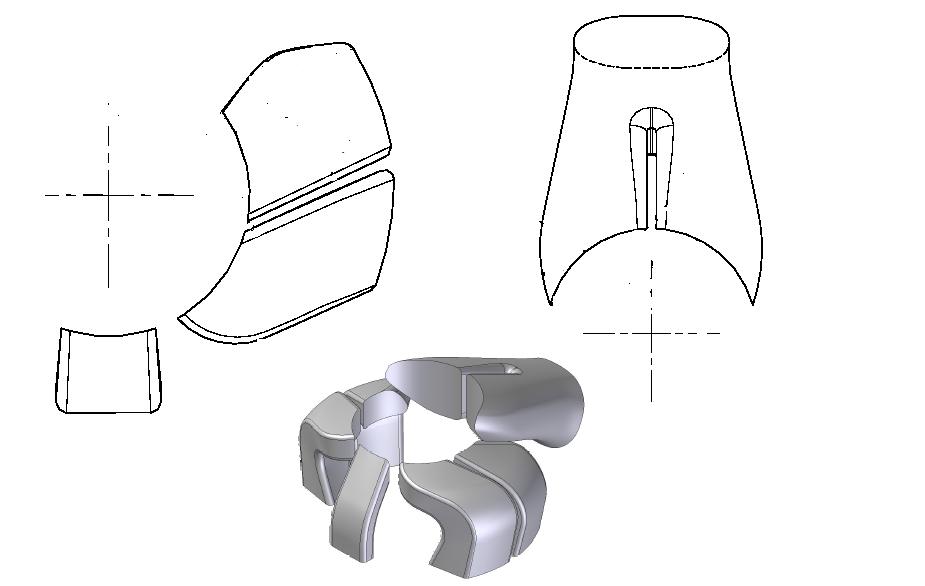





Gas flow past bridges (surface area) will signifcantly slow down.
I remember some years ago reading about the CR 250 1974? having a lot more exhaust area but because of the bridge, in fact flowed less gas than the YZ 250 ( single port).
But you are right there is more going on in the Ryger than this.
I am not convinced as the cylinder pressure at blowndown is bloody high. look at how the gases are able to escape those poppet valve curios.
Sure total gas flow will be higher but I don't think that is as much of an issue as the blow down time area.
I am still on the theory they have brought more time with higher delivery pressure of the transfers and or dwelling

Kinky is using a feather. Perverted is using the whole chicken

I never did try the raised bottom exhaust port, but have seen it done. On the smaller engines it is too hard to tell if it really is and advantage or not.
But one thing I have seen is when the bottom corner of the exhaust was made as a big radius with a 30 deg chamfer slope towards the center. That had a very big negative effect on the engine's performance compared to the 1/16 corner radius and a flat bottomed exhaust. It was done initially as a means of making sure there could not be any sub piston induction. I will have to try the raised floor though and see what the effects are with the smaller engines.
Some one mentioned about labyrinth ring grooves on a piston. These have bee tried by lots of modelers with varying success, but the reality on the model engines is if the surface finish is right to start with and the amount of taper to compensate for the liners growth with the heat. With a properly
made piston and liner surface finish, adding the labyrinth grooves does not make the engine produce any more power or add to the longevity of the sealing ability of the assembly. Better metallurgy was the key for the success of the ringless high performance model engines. With more time and development, I am sure that there could be a combination that could work with bigger piston sizes like those closer to 40mm or 50mm diameter.
A lot of current small engines are using RSP444 which has about 30% silicon in it and is very low expansion material. The trick will be to find a liner material that matches that expansion rate.
Sometimes small changes can have a substantial effect, it is just a matter of finding the combinations that work the best.
Neil
You want a liner that matches the piston's expansion, but not its expansion rate. That would only make sense if the liner became as hot as the piston, which in turn would mean that the piston could no longer transfer its heat to the liner, which would mean the piston would get hotter than the liner: Catch22.

On the bridged port NiCasil MX engines I still occasionally do, I send cylinder off with no port chamfering... and instructions for them to not do any chamfering. I only radius top edge of ex port. All other ports I don't even touch. I believe this helps with short circuiting, and a nice consistent transfer opening. Never had a problem with rings

Yeah , you are right Frits, bad wording on my behalf. With some model engines, they make the liners expand slightly more than the piston, so if the engine runs lean and over heats, the engine just looses seal pressure then slows down, or stops. Then if allowed to just cool, it is all fine with no damage to the piston/liner fit. The big end bearing on the rod or the crank pin may have an issue though.
The best engines seem to show no signs of rubbing the piston on the cylinder bore,apart from the seal land area, and I have always assumed that the cooling occurred mainly due to the oil underneath in a 4s situation or the incoming air/fuel in a 2s situation.
Neil


Now that I am interested in the NSR110cc water cooled engine I looked up the Honda RS port info and Yamaha SAE paper posted earlier on transfer ports. Like Wob and Frits say, the A ports are inclined up the steepest with B much shallower and C (boost port) at 55 deg. The link has pictures and link to a Yamaha SAE paper on transfer ports.

For comparison Honda Rs Scavenge

If you look at the porting from side on you will se why it is they are arranged like this.
The scavenge pattern is arranged to prevent short circuiting and have the rising columns colliding in such a manner that the they do not escape and are able to fill the cylinder both quickly and efficiently.
Frits from memory did a nice piece on it around xmas 2 years ago
http://www.kiwibiker.co.nz/forums/sh...post1130452977
Pretty sure I have pics of a cut up Honda cylinder.
http://www.kiwibiker.co.nz/forums/sh...post1130766509
Plenty of RS pics here
http://www.kiwibiker.co.nz/forums/al...id=4841&page=7
The KTM is worth a look pretty much a Honda.
http://www.kiwibiker.co.nz/forums/al...p?albumid=4857
One you posted years ago
http://www.kiwibiker.co.nz/forums/sh...post1129196083
http://www.kiwibiker.co.nz/forums/at...6&d=1241260771

Kinky is using a feather. Perverted is using the whole chicken

Does anyone have a bike I could ride tomorrow please for a small fee?






frits i have discovered the secret of ryger. it must use one of these gadgetshttp://www.ebay.com/itm/Pulse-Inject...e3c422&vxp=mtr
There are currently 5 users browsing this thread. (0 members and 5 guests)
Bookmarks